#Extatosoma tiaratum
Text

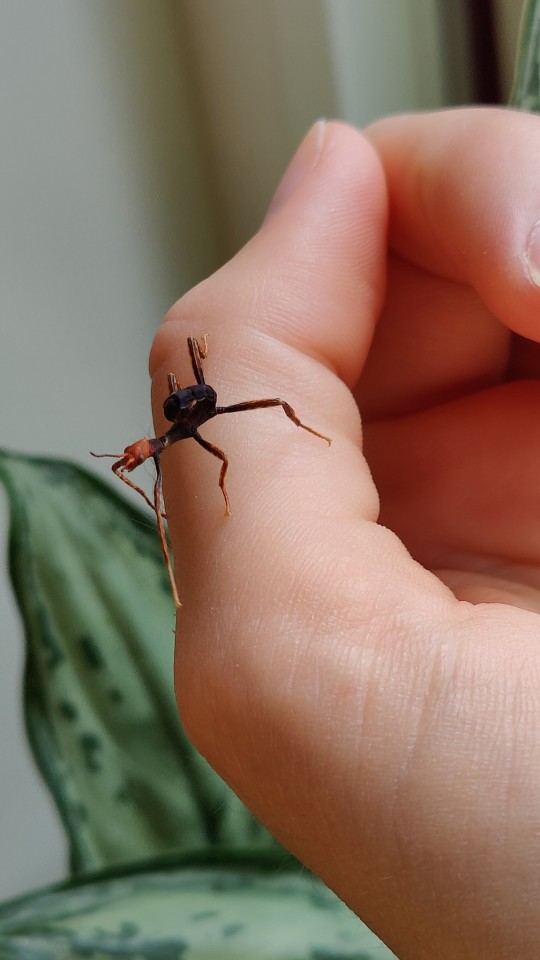
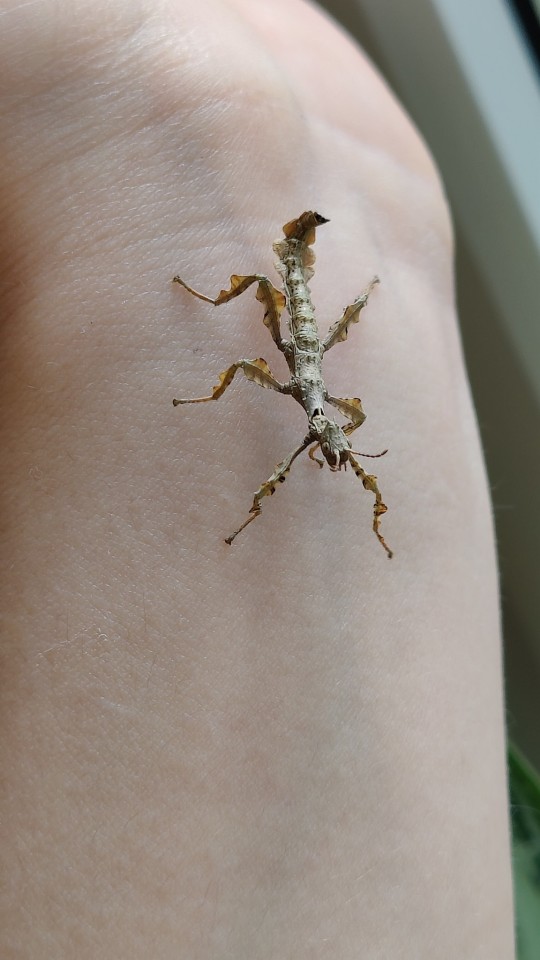

Newly hatched Extatosoma tiaratum vs 2 weeks!
They mimic ants for the first while, which is why they are dark and curl their abdomen. The oldest one is actually starting to look like a leaf!
72 notes
·
View notes
Photo

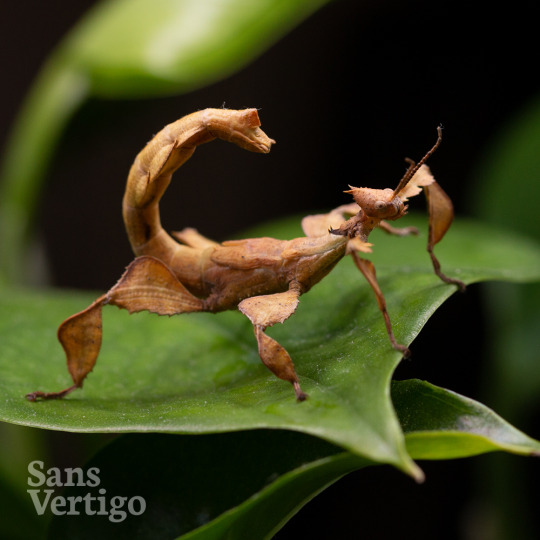
Juvenile spiny leaf insects!
You can already see the sexual dimorphism in these two. The female has spines along her abdomen, while the male does not.
They are also available for sale on our Aussie store.
13 notes
·
View notes
Text
she dont know NOTJIN. not a goddamn clue what the economic state of the world is rn. i cannot cope abt how cute the tiny ones are i am gonn fuckin cry

#stick bug#phasmid#phasmatodea#entomology#bug#insect#bugs#extatosoma tiaratum#spiny stick insect#prickly stick insect#i didnt take my meds today
5 notes
·
View notes
Text

We’re on an Insect roll at the moment, and here is probably one of the coolest bugs I’ve ever seen: The Spiny Leaf Insect! They are also known as Australian Walking Sticks and are a species of Phasmatids.
Honestly, Spiny Leaf Insect sounds more like a general description than an actual name-
#Phylum: Arthropoda#Class: Insecta#Order: Phasmatodea#Family: Phasmatidae#Subfamily: Extatosomatinae#Genus: Extatosoma#Extatosoma tiaratum#Australian walking sticks#Spiny leaf insects#Walking sticks#leaf insects#Phasmatids#insects
0 notes
Text

In memory of my pet phasmids, it's been a few years now but I still miss them.
#insects#phasmids#bugs#furry#i also had 3 phillium philipinicum#i had 2 extatosoma tiaratum#the leafies were called frog & danny phasmid & bulbasaur#the sticks were called ginger and spike#they died of old age they had a good life :)#not once did my extatosoma do a threat display#they only curl up like in typical photos when threatened#but mine were never scared#well all of them wiggled when i changed the bramble for them but i never stressed them out#i only had one leg drop too! danny phasmid got spooked by her sisters and i found her one leg down in the morning#it grew back tho :)#man ok enough rambling#my art#my post
8 notes
·
View notes
Note
I've got an interesting idea for a bug race for a one piece au! Since there is Fishmen and Minks with many distinct animal and fish features in their appearance so how about a race with insect, arachnid and other invertebrate features! 🐌🦋🐛🐜🐝🪲🐞🦗🪳🕷️🕸️🦂🦟🪰🪱 And what kind of bug would each straw hat member be in this AU?
Okay so fun fact about me, I was an entomology major in college before I dropped out. So thank you for this request because it was very self indulgent!
Insect AU
Luffy would be a jack jumper ant (Myrmecia Pilosula). This ant is very strong even by ant standards. Like their name suggests, they can leap up to 76 millimeters, which is extremely impressive when you take into account that they range from 11 - 14 millimeters in size. On top of that, they possess a potent venom that kills other insects with ease. They are notably aggressive, even towards things much larger than themselves, and can reliably kill prey much larger than themselves. Truly a fierce fighter that can go toe to toe with many enemies.
Zoro would be a centipede, specifically the Scolopendra Polymorpha. This centipede varies a lot in color, and can even be green. These guys pack some pretty serious venom with necrotic properties, not something you want to experience. Centipedes are extremely agile predators that can take down all kinds of prey with ease thanks to their strength and ability to contort their body.
Nami would be a velvet ant (Dasymutilla Occidentalis). Despite the name, these guys are not ants, but are ground dwelling wasps that happen to resemble ants. They have a deceptively cute reddish-orange fuzzy appearance, that makes their venomous sting all the more surprising. While only males of the species can fly, females have a stinger that delivers a devastating venom to whatever has it on the defense. While the effects of it are excruciating, it is not fatal.
Usopp would be a spiny leaf insect (Extatosoma Tiaratum). Despite the name, males don’t have many spikes beyond the ones on their face and some defensive ones on the legs, but they can fly so at least they have that going for them. One of their means of defense is to do a threat pose that makes them resemble a scorpion (and the nymphs mimic the appearance of a toxic species of ants), which sounds like a very Usopp thing to do in my humble opinion.
Sanji would be a budwing mantis (Parasphendale Affinis). This is widely considered to be the most aggressive mantid species. I will preface this by saying that this mostly applies to females, but for the sake of the AU, I’m going to ignore that and allow Sanji to have these qualities. The budwing mantis is a voracious predator that regularly kills prey three times the size of themselves, and will do their damnedest to intimidate even bigger animals. These guys are ambush predators with insanely fast reflexes. Males are especially eager to find a mate (however fatal that may be).
Chopper is a bumblebee, specifically the Bombus Balteatus. Why did I choose that one, you ask? Because it was the fluffiest looking one I could find. As for the rest of the reasoning, Chopper just has cute bumblebee vibes to me. He likes using his honey in his medicine when applicable. This is another case of us ignoring insect gender-roles.
Robin is a noble false widow spider (Steatoda Nobilis). This spider is commonly mistaken for black widows even though I don’t get how because they look nothing alike I mean really it’s like saying wolf spiders look like a brown recluse, so they have an unfairly bad reputation. While their venom is medically significant, it’s on par with a bee sting and nothing to worry about.
Franky is an atlas beetle (Chalcosoma Atlas). These are massive beetles with a very tough shell and most notably, have three long horns both for defense and mating purposes. Despite their intimidating size, they are actually quite friendly and make for great pets.
Brook would be a prairie mole cricket (Gryllotalpa Major). Despite the name, these aren’t true crickets, just a close relative. Lacking the specialized legs that crickets use to chirp, they instead rub their wings together to make noise. They dig burrows specifically designed to have excellent acoustics so as to help more females hear their “music”, which is surprisingly complex and can have up to five harmonics.
Jinbei would be a lobster. Not really an insect, but a relative of them no less.
#one piece#monkey d luffy#zoro roronoa#luffy#nami#cat burglar nami#one piece nami#usopp#sanji#black leg sanji#tony tony chopper#nico robin#franky the cyborg#cyborg franky#brook#soul king brook#jinbei#insect au
51 notes
·
View notes
Note
Hello! My cowoker's phasmids had babies awhile back and so I've recently come in possession of an Extatosoma tiaratum. Do you have any pointers on what to fill her enclosure with to make sure she's healthy and entertained? I'm feeding her Himalayan blackberry leaves because we have that everywhere. She's already the size of half my fist and I was told she'll grow even bigger.... Already quite the poop machine lol.
I have no experience with phasmids but other than having lots of food always available I’m not sure if anything else is really necessary! they want to hang around on their food, and eat their food, and that’s about it. maybe have some sturdier sticks about for molting in case she eats everything firm enough to hold her weight?
also, if you haven’t heard of the “lichen morph” E. tiaratum, it’s something I’ve always wanted to see! apparently raising nymphs in lichen-rich environments can trigger a change to a very different color morph. I’m not sure if all members of the species have the genetic basis to trigger the morph, and yours may already be too large to start it
49 notes
·
View notes
Text
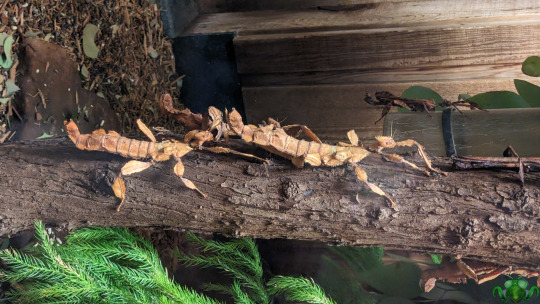
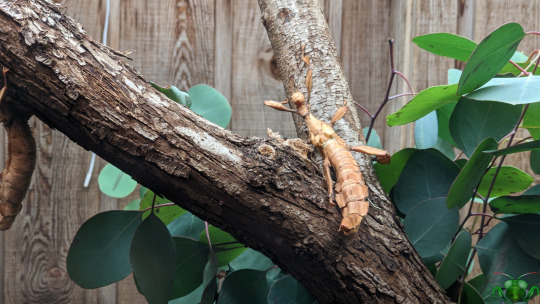
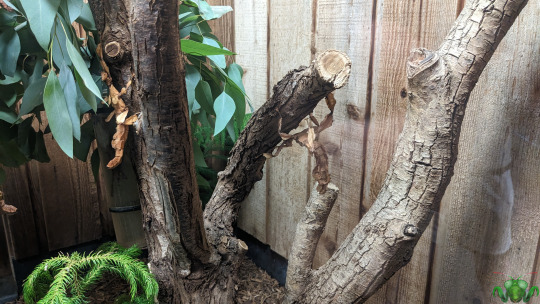
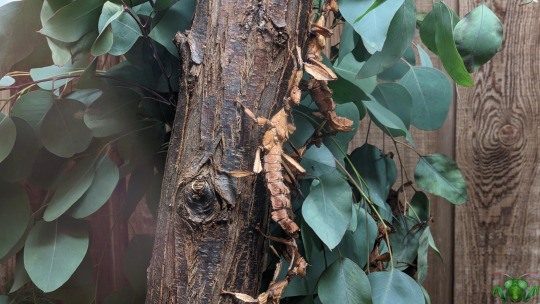
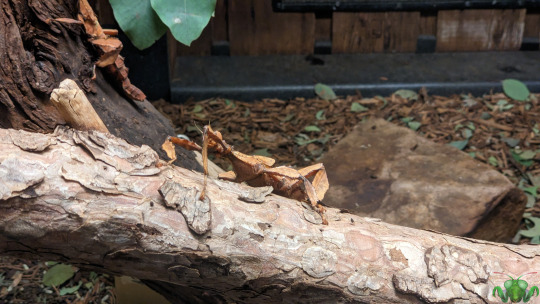
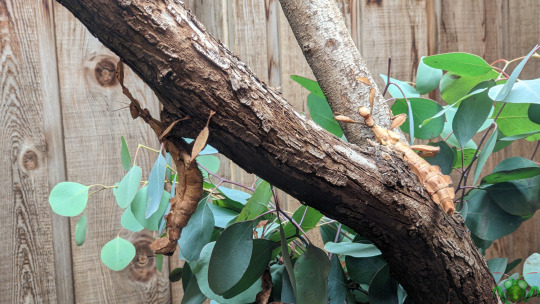



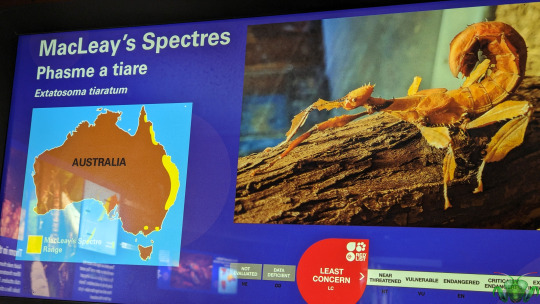
Spiny Leaf Insect - Extatosoma tiaratum
It's been many years since I've laid my eyes on one of these magnificent creatures, and even longer since my days at UofT where I held one in my hand. As such, it was gratifying to see so many individuals on display at the Toronto Zoo and to soak in all their details and movements (mostly wobbles and slow, methodical steps) while observing them. With many female individuals, and a few different instars among them, I should have taken a video, but there was lots of exciting screaming in the background from the otters and reptiles. As much as I love animals, this blog is all about the insects, and so today we have pictures of these Giant Prickly Stick Insects. Today, they are known by many names such as Australian Walking Sticks, Spiny Leaf Insects, Macleay’s Spectres (named for British entomologist William Macleay and referencing their order Phasmatodea, whose name is derived form apparitions or more commonly, ghosts) or E. tiaratum. What ever you call them, just don't call them "Leaf Insects". Those are a different branch of Phasmid, of the family Phylliidae. Amazing as the former are, these large armored insects also have a certain special quality to them. Maybe it's just how large and unusual they are compared to our fauna, but I certainly think that they're eye-catching when they can actually be found and observed. In the wild, finding them is far more difficult since their mottled, spiked, dried-in-appearance leafy armor is meant to hide them from their predators.
These peaceful, plant-eating giants need every advantage they can secure since they aren't aggressive and are burdened with slow movement due to their armor. In most cases, if anything gets close, the "scorpion" posture combined with a mild chemical defense and their sharp spines may be just enough. But what if you're a thinner, more agile male? If you've been observant, there is one such darker individual in the background of Picture 1! They're quite different in appearance from females, being much smaller and slimmer, and they are also quite rare! Moreover, a mild reliance on using parthenogenesis to reproduce and lay eggs, they can become even rarer! The thin male has functioning wings and can use them when in danger by either flying away or flashing them to a predator, startling them. Naturally, wings also allow for a wider dispersal and an expansion to the search for fertile females. In an environment within captivity, the presence of a male may be likely to discourage parthenogenesis and in fertilized eggs that will hatch earlier after females drop them to the soil floor. There were no eggs to be found, so if you plan to visit and search for them, look for brown and white, seed-like objects fitted with a capsule-like projection (capitulum). They are likely to be removed and stored, as the eggs of E. tiaratum are reported to need cooler conditions to successfully hatch. Their terrarium may simulate a warm, tropical environment too well in that case. In the wild, Ants fulfill this condition, bringing the "seeds" underground into their food stockpile.
These insects are exhibited in the Toronto Zoo, so I’ve marked them with the Mantis icon. Pictures were taken August 27, 2023 at the Toronto Zoo with a Google Pixel 4. Please go and visit the animals (insects very much included).
#jonny’s insect catalogue#ontario insect#stick insect#spiny leaf insect#macleay's spectre#phasmatodea#phasmid#insect#toronto#toronto zoo#august2023#2023#nature#entomology#invertebrates
10 notes
·
View notes
Text
The creative variation of stick insect egg cases.
Female stick bugs lay eggs in small groups, or one at a time, on random leaves, or simply dropping them on the forest floor. The eggs are little works of art, tiny sculpted vases, when the nymph emerges it will unfold to be much longer than the egg. (Photos by François Tetaert)

FIGURE 3 | Stick and leaf insect eggs illustrating the breadth of their phenotypic diversity. Eggs depicted in the top two rows have capitula. Corresponding taxonomic
names are provided in Supplementary Table S3. Photos by François Tetaert.
Photo from: Evolution of Oviposition Techniques in Stick and Leaf Insects (Phasmatodea) James A. Robertson Sven Bradler and Michael F. Whiting.
Ants sometimes play a role in the dispersal of stick insect eggs (lol did you think there would be no ants in this story? LMAO. Come on.) basically the stick insect uses the same strategy as many plants. They don't just imitate the appearance of plants!
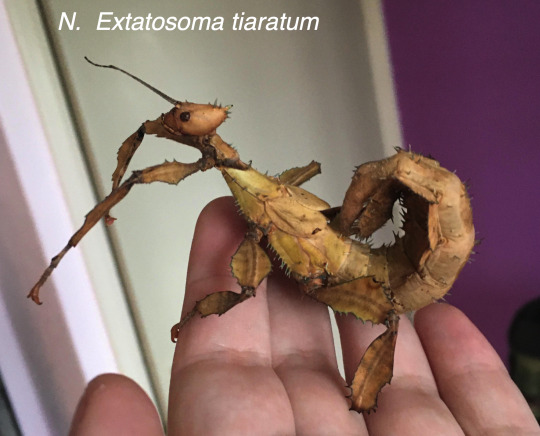
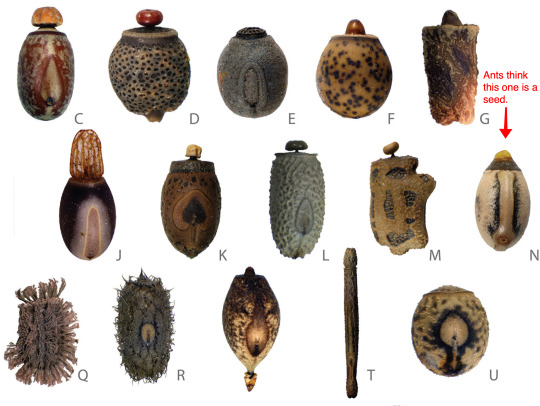
Photo of tiaratum via reddit.
The stick insect creates an egg/seed with a hard to remove edible reward, this causes ants to drag the eggs long distances. If you know ants are going to move your eggs for you... why not mimic ants too when you are too little to be mistaken for a plant?

The order containing stick insects is called Phasmatodea. What a remarkable bunch! There is a table showing their lineage and the many ways they disperse their eggs in this fantastic paper. Check it out! (free to download, lots of photos)
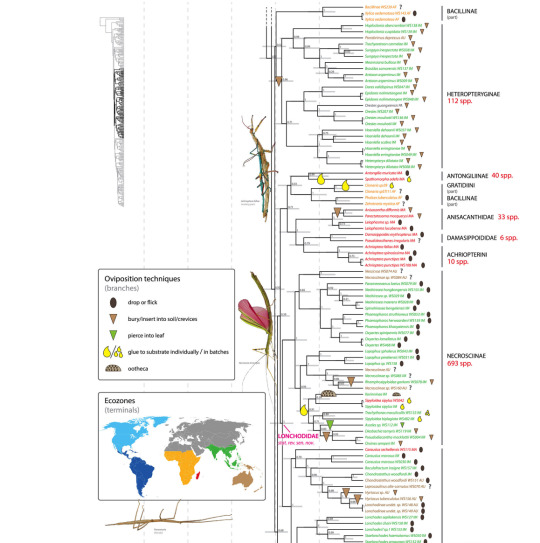
Last, here is the first photo again along with the scientific names for the species that created each egg case.

A Pharnacia ponderosa
B Dimorphodes sp.
C Eurycnema osiris
D Lonchodes malleti
E Cranidium gibbosum
F Paramenexenus laetus
G Melophasma antillarum
H Acrophylla wuelfingi
I Alienobostra brocki
J Bacteria horni
K Baculonistria alba
L Lonchodes dalawangsungay
M Lonchodes philippinicus
N Extatosoma tiaratum
O Asystata sp.
P Phyllium bioculatum
Q Phyllium mabantai
R Isagoras sp.
S Marmessoidea sp.
T Medaurini sp.
U Menexenus fruhstorferi
V TTisamenus serratorius
W Haaneilla erringtoniae
X Pylaemenes guangxiensis
Y Diapherodes martinicensis
Z Pijnackeria masettii
A’ Aretaon sp.
B’ Necrosciinae sp.
C’ Necroscia annulipes
D’ Parapachymorpha spinosa
E’ Orixines xiphias
F’ Neohirasea nana
G’ Xenophasmina sp.
H’ Pseudophasma subapterum
I’ Necrosciinae sp.

Lovely ultra-macro shot of the head of a female Extatosoma tiaratum from wikimedia commons.
#stick insect#invertebrates#bugs#bugblr#ants#antposting#stick bug#bug#i love bugs#antblr#bugcore#bugposting#entomology#insects#Phasmatodea#seed dispersal#science#ecology#biology#animals
49 notes
·
View notes
Note
Ahhh you have stick insects?? Show me please 👀👀👀👀
Of course! 💚😌
I said 'stick insects' in the tag game because I didn't know the right English term for 'Gespenstschrecken'. Not 'stick insects' but 'ghost insects'.
Get ready for some cute pics!! 🥺 I took these photos a few years ago and my beloved insects are in insect Heaven now, but I really wanna get back into the hobby 😌
Sungaya inexpectata, female / her Name was Paige

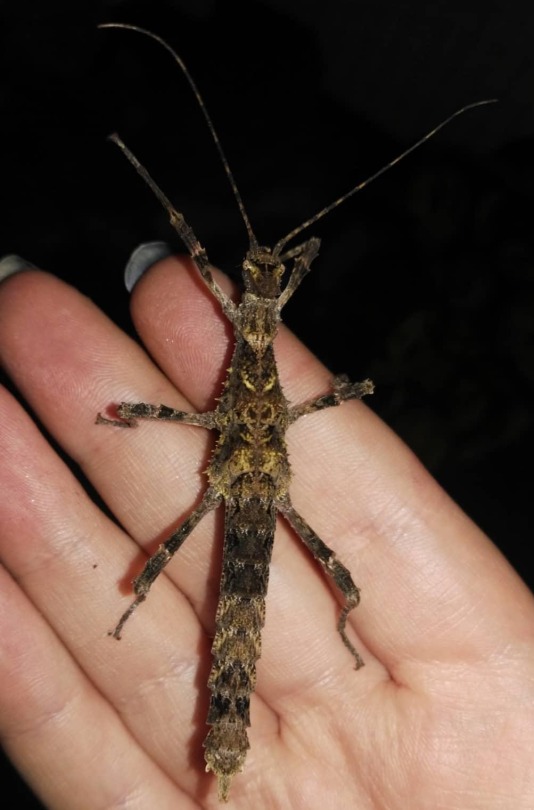
She had a boyfriend and his name was Skinny (😏). After their mating session I had sooo many eggs and babies. It was a mess.
Extatosoma tiaratum / Australische Gespenstschrecke / her name was Laurie

When this little cutie arrived, she only had five legs and I needed to be very gentle with her. Then she molted... and she was even prettier!
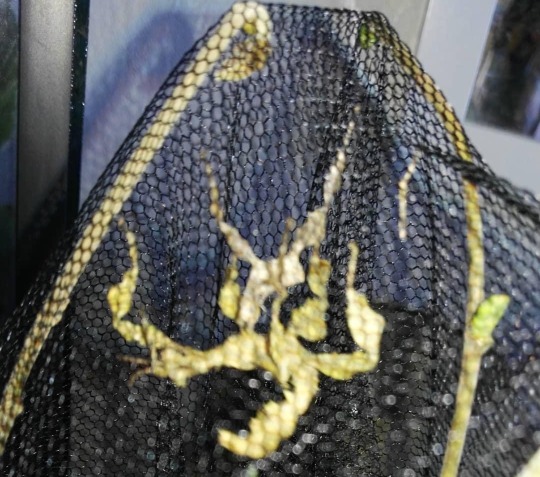

I called her 'my little dragon' or 'dinosaur'. What makes the Australian walking stick so fascinating is that their walk is really wobbly. They imitate a leaf moving in the wind! So they're just dancing around all the time!
They strike a defense pose when threatened and sometimes lash out at you to scare you off.

Archispirostreptus gigas / Afrikanischer Riesentausendfüßer / their names: Bob & Justus

I had two of them and they were really chill. They spray a stinky liquid onto your skin, when they feel threatened. Just like a ladybug. But handling them was quite cool. They crawled over my arms and just sat on my shoulder, while I cleaned their enclosure.
I'm sorry! This post is really long, but I love insects so much and I'm soo happy you asked! 💚😊 Thank you!!
5 notes
·
View notes
Photo
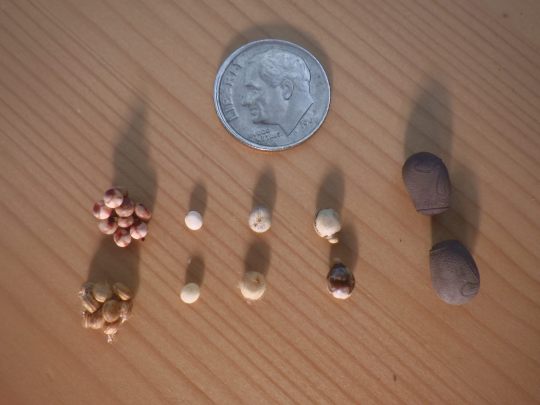
Insect eggs from left to right: clusters of Atlas moth eggs; Saturniid moth eggs; Madagascan comet moth eggs; Extatosoma tiaratum eggs (Macleay’s Spectre Stick Insect); Heteropteryx dilatata eggs (Jungle Nymph Stick Insect).
#egg#eggs#insect#insects#insect egg#insect eggs#moth#moths#atlas moth#atlas moths#moth egg#moth eggs#saturniid#saturniids#madagascan comet moth#madagascan comet moths#stick insect#stick insects#stick insect egg#stick insect eggs#macleay's spectre stick insect#extatosoma#extatosoma tiaratum#jungle nymph stick insect#heteropteryx#heteropteryx dilata#nature
2 notes
·
View notes
Video
youtube
Laying eggs is hard work: Extatosoma tiaratum
0 notes
Photo
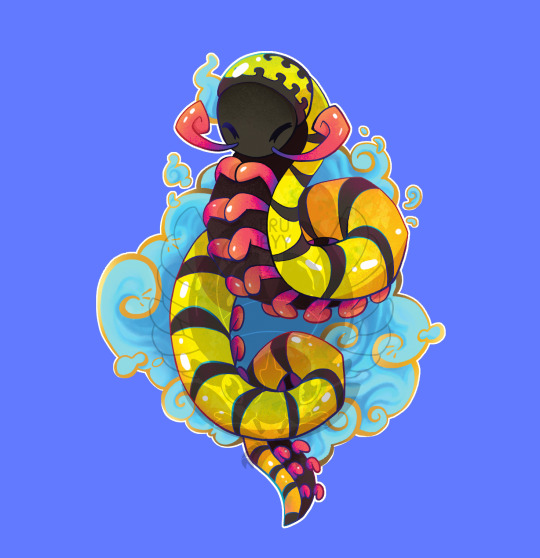
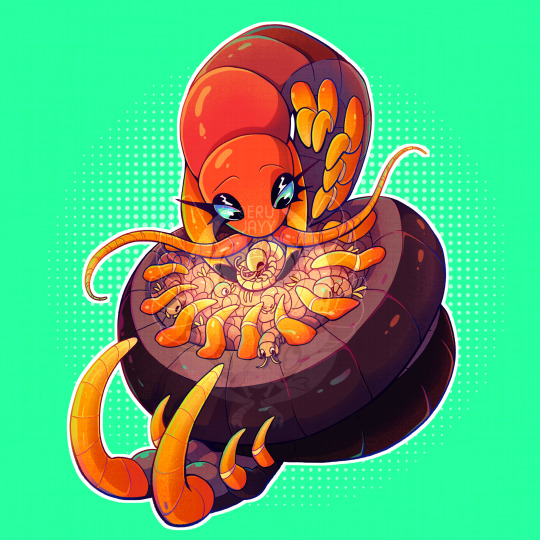


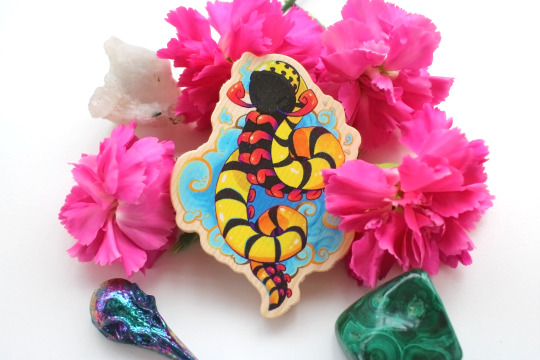


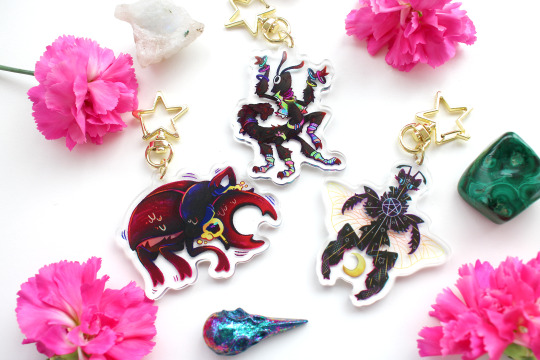
! FUNK BUGS !
Cute little critters to adorn your cave with.
Species: Bumblebee millipede | Desert Centipede | Trilobite Beetle | Prickly Stickbug | Stag Beetle | Orchid Mantis
Wooden pins 1 | 2 | 3
Charms
Stickers
#insect#bug#insect art#bug art#bugs#beetle#millipede#centipede#myriapod#trilobite#stickbug#mantis#orchid mantis#extatosoma tiaratum#reblogs really appreciated!!#etsy#charm#stickers#aesthetic#moodboard#pin#pins#wooden pin#myart#shop
542 notes
·
View notes
Text
NOOOOOOOO
#inverts#invertebrates#bugs#insects#stick insects#stick insect#phasmids#bugblr#extatosoma tiaratum#mine#cute bugs
125 notes
·
View notes
Photo
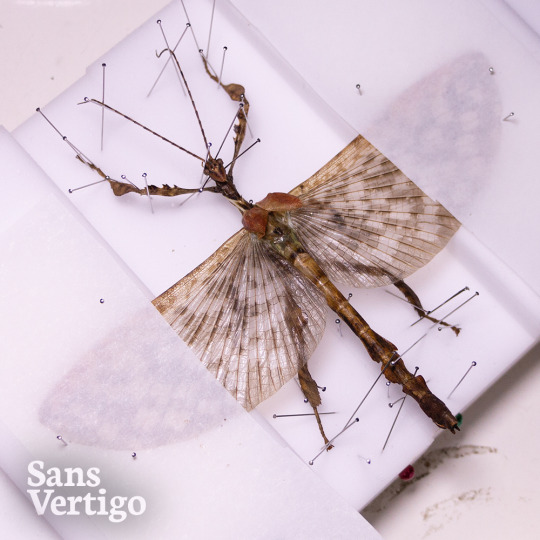
Dry preservation of Male Spiny Leaf Insect
Extatosoma tiaratum
The males of this species don’t live very long, so this guy passed away after a good 6 months of adulthood. He was quite difficult to handle though, preferring to fly away or play dead. I like to preserve old pets to keep as mementos and examples.
29 notes
·
View notes